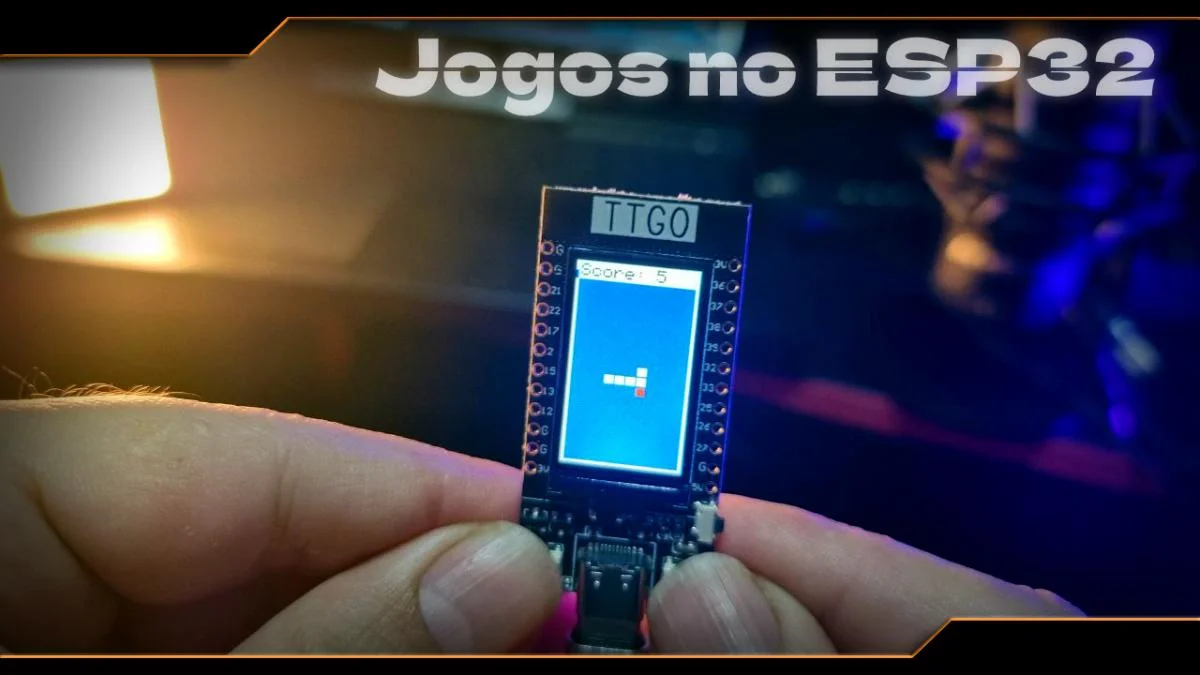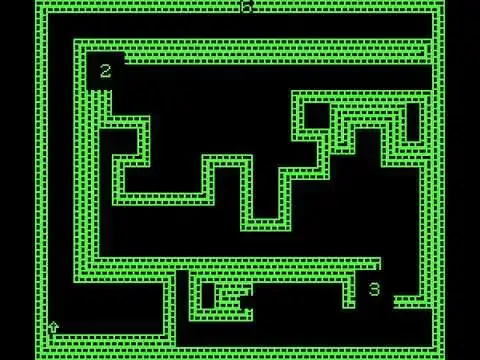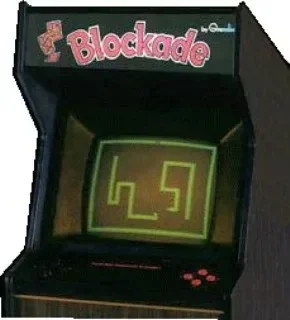Manual
do
Maker
.
com
Jogos no ESP32 #02: Snake

A Nokia nos presentou em seu auge com algo que nos marcou para sempre; o jogo Snake, que fez parte de nossas vidas de algum modo, em seus indestrutíveis celulares quando o jogo surgiu; na época dos display 5110, que sequer sabíamos seu nome, mas já cruzara nosso destino para que hoje pudéssemos nos reencontrar. E o que parecia ser incrível, consegue hoje ser mais incrível, rodando em um ESP32 com meras 300 linhas de lógica!
Blockade
Uma curiosidade é que o jogo Snake não foi uma ideia original. O jogo se baseia no Blockade, de 1976! O Snake foi criado por Taneli Armanto em 1997.


Combinemos que o jogo Tron também é uma variação, hum?
TFT_eSPI
Se você precisa desenhar o que vai aparecer na tela, sem dúvidas a biblioteca TFT_eSPI é a melhor escolha. Quase tudo que tenho visto há algum tempo é feito com essa biblioteca. A primeira versão do Color Mixer foi feita com uma adaptação de um sketch, permitindo que eu dedicasse o tempo à lógica do dispositivo. No artigo disponibilizo tudo para você também fazer o seu. De nada. E a bomba peristáltica é da Robocore, indústria brasileira, que consegue fazer um preço bastante agradável nessa belezinha. Para concluir, se desejar, veja o vídeo do misturador de cores em ação.
LVGL
Mas, não posso deixar de falar da biblioteca LVGL, porque se está procurando por algo que facilite a vida na hora de construir widgets, a biblioteca certa é essa. Gosto tanto dela que fiz uma playlist com vários projetos. Se clicar nesse link interno do blog, vai ver um monte de tutorial também. Não tem desculpa.
Mas e the f*** game? Cadê?
Está ansioso? Eu também estava. Bem, logo mais eu publico o repositório com os jogos que estou apresentando, mas por enquanto você pode copiar esse código a seguir para um sketch e fazer o upload, "desde que" tenha configurado a biblioteca TFT_eSPI como descrito no vídeo do T-Rex.
/////////////////////////////////////////////////////////////////////////////
//
// A Simple Game of Snake
// ESP32 + TFT_eSPI on TTGO T-Display
float gameSpeed = 5; //Higher faster
//#include <Adafruit_GFX.h>
#include <SPI.h>
#include <TFT_eSPI.h>
#ifndef TFT_DISPOFF
#define TFT_DISPOFF 0x28
#endif
#ifndef TFT_SLPIN
#define TFT_SLPIN 0x10
#endif
#define ADC_EN 14
#define ADC_PIN 34
#define BUTTON_1 35
#define BUTTON_2 0
#define blue_width 129
#define blue_heigh 216
boolean start = false; //will not start without say-so
unsigned long offsetT = 0; //time delay for touch
unsigned long offsetM = 0; //time delay for main loop
float gs;
int headX = 1; //coordinates for head
int headY = 1;
int beenHeadX[170]; //coordinates to clear later
int beenHeadY[170];
int changeX = 0; //the direction of the snake
int changeY = 1;
boolean lastMoveH = false; //to keep from going back on oneself
int score = 1;
int foodX; //coordinates of food
int foodY;
boolean eaten = true; //if true a new food will be made
int loopCount = 0; //number of times the loop has run
int clearPoint = 0; //when the loopCount is reset
boolean clearScore = false;
uint32_t suspendCount = 0;
//initialize the display
TFT_eSPI tft = TFT_eSPI(135, 240);
void setup() {
gs = 1000 / gameSpeed; //calculated gameSpeed in milliseconds
memset(beenHeadX, 0, sizeof(beenHeadX)); //initiate beenHead with a bunch of zeros
memset(beenHeadY, 0, sizeof(beenHeadY));
tft.begin(); //turn on display
tft.setRotation(0);
tft.fillScreen(TFT_WHITE); //sets background
tft.fillRect(3, 21, blue_width, blue_heigh, TFT_SKYBLUE);
tft.setTextColor(TFT_WHITE); //Start notification
tft.setTextSize(3);
tft.setCursor(0, 120);
tft.print(">START<");
tft.setTextColor(TFT_BLACK); //Score keeper
tft.setTextSize(2);
tft.setCursor(5, 3);
tft.print("Score: ");
printScore();
randomSeed(analogRead(6)); //make every game unique
pinMode(BUTTON_1, INPUT_PULLUP);
pinMode(BUTTON_2, INPUT_PULLUP);
attachInterrupt(digitalPinToInterrupt(BUTTON_1),right, FALLING);
attachInterrupt(digitalPinToInterrupt(BUTTON_2),left, FALLING);
}
void loop() {
if (suspendCount++>10000000) suspend(); //auto suspend after ~10 sec.
if (clearScore and start) { //resets score from last game, won't clear
score = 1; //until new game starts so you can show off
printScore(); //your own score
clearScore = false;
}
if (millis() - offsetM > gs and start) {
beenHeadX[loopCount] = headX; //adds current head coordinates to be
beenHeadY[loopCount] = headY; //covered later
headX = headX + (changeX); //head moved
headY = headY + (changeY);
if (headX - foodX == 0 and headY - foodY == 0) { //food
score += 1;
printScore();
eaten = true;
}
loopCount += 1; //loopCount used for addressing, mostly
if (loopCount > 169) { //if loopCount exceeds size of
clearPoint = loopCount - score; //beenHead arrays, reset to zero
loopCount = 0;
}
drawDot(headX, headY); //head is drawn
if (loopCount - score >= 0) { //if array has not been reset
eraseDot(beenHeadX[loopCount - score], beenHeadY[loopCount - score]);
} //covers end of tail
else {
eraseDot(beenHeadX[clearPoint], beenHeadY[clearPoint]);
clearPoint += 1;
}
if (eaten) { //randomly create a new piece of food if last was eaten
do { //but not inside the snake's body
foodX = random(2, 9);
foodY = random(2, 17);
} while (belongsToBody(foodX, foodY));
eaten = false;
}
drawDotRed(foodX, foodY); //draw the food
if (headX > 10 or headX < 1 or headY < 1 or headY > 18) { //Boudaries
endGame();
}
if (belongsToBody(headX, headY)) {
endGame();
}
offsetM = millis(); //reset game loop timer
}
}
void endGame() {
tft.fillRect(3, 21, blue_width, blue_heigh, TFT_BLUE); //deletes the old game
eaten = true; //new food will be created
tft.setCursor(30, 100); //Retry message
tft.setTextSize(3);
tft.setTextColor(TFT_WHITE);
tft.print("GAME");
tft.setCursor(30, 130);
tft.print("OVER!");
tft.setTextColor(TFT_BLACK); //sets back to scoreboard settings
tft.setTextSize(2);
tft.setCursor(5, 3);
tft.print("Score: ");
headX = 1; //reset snake
headY = 1;
changeX = 0;
changeY = 1;
lastMoveH = false;
memset(beenHeadX, 0, sizeof(beenHeadX)); //clear the beenHead arrays
memset(beenHeadY, 0, sizeof(beenHeadY)); //probably not necessary
loopCount = 0;
clearScore = true;
start = false; //stops game
}
void drawDot(int x, int y) {
tft.fillRect(12*(x-1)+5, 12*(y-1)+23, 10, 10, TFT_WHITE);
}
void drawDotRed(int x, int y) {
tft.fillRect(12*(x-1)+5, 12*(y-1)+23, 10, 10, TFT_RED);
}
void eraseDot(int x, int y) {
tft.fillRect(12*(x-1)+5, 12*(y-1)+23, 10, 10, TFT_BLUE);
}
void printScore() {
tft.fillRect(88, 3, 50, 16, TFT_WHITE);//clears old score
tft.setCursor(88, 3);
tft.print(score); //prints current score
}
bool belongsToBody(int x, int y)
{
if (loopCount - score < 0) { //check to see if head is on tail
for (int j = 0; j < loopCount; j++) {
if (x == beenHeadX[j] and y == beenHeadY[j]) {
return true;
}
}
for (int k = clearPoint; k < 152; k++) {
if (x == beenHeadX[k] and y == beenHeadY[k]) {
return true;
}
}
}
else {
for (int i = loopCount - (score - 1); i < loopCount; i++) {
if (x == beenHeadX[i] and y == beenHeadY[i]) {
return true;
}
}
}
return false;
}
void espDelay(int ms)
{
esp_sleep_enable_timer_wakeup(ms * 1000);
esp_sleep_pd_config(ESP_PD_DOMAIN_RTC_PERIPH, ESP_PD_OPTION_ON);
esp_light_sleep_start();
}
void suspend()
{
suspendCount=0;
int r = digitalRead(TFT_BL);
tft.fillScreen(TFT_BLACK);
tft.setTextColor(TFT_GREEN, TFT_BLACK);
tft.setTextSize(1);
tft.setTextDatum(MC_DATUM);
tft.drawString("Press again to wake up", tft.width() / 2, tft.height() / 2);
espDelay(4000);
digitalWrite(TFT_BL, !r);
tft.writecommand(TFT_DISPOFF);
tft.writecommand(TFT_SLPIN);
//After using light sleep, you need to disable timer wake, because here use external IO port to wake up
esp_sleep_disable_wakeup_source(ESP_SLEEP_WAKEUP_TIMER);
// esp_sleep_enable_ext1_wakeup(GPIO_SEL_35, ESP_EXT1_WAKEUP_ALL_LOW);
esp_sleep_enable_ext0_wakeup(GPIO_NUM_35, 0);
delay(200);
esp_deep_sleep_start();
}
void left() {
suspendCount=0;
if (start)
{
if (millis() - offsetT > gs and !lastMoveH) {
//if (changeY==-1)
//{
changeX = -1;
changeY = 0;
offsetT = millis();
lastMoveH = true;
//}
}
else if (millis() - offsetT > gs and lastMoveH) {
if (changeX==1)
{
changeX = 0;
changeY = -1;
offsetT = millis();
lastMoveH = false;
}
else if (changeX==-1)
{
changeX = 0;
changeY = 1;
offsetT = millis();
lastMoveH = false;
}
}
}
else if (millis() - offsetT > gs and !start)
{
tft.fillRect(3, 100, 126, 60, TFT_BLUE); //Erase start message
start = true; //allows loop to start
offsetT = millis();
}
}
void right() {
suspendCount=0;
if (millis() - offsetT > gs and !lastMoveH) {
//if (changeY==-1)
//{
changeX = 1;
changeY = 0;
offsetT = millis();
lastMoveH = true;
//}
}
else if (millis() - offsetT > gs and lastMoveH) {
if (changeX==1)
{
changeX = 0;
changeY = 1;
offsetT = millis();
lastMoveH = false;
}
else if (changeX==-1)
{
changeX = 0;
changeY = -1;
offsetT = millis();
lastMoveH = false;
}
}
}
Vídeo
Fiz um vídeo extremamente curto para apresentar o jogo e também indicar esse artigo, mas falta editar. Então não perca a oportunidade de me fazer feliz e inscreva-se no canal DobitaobyteBrasil no Youtube e clique no sininho para ser notificado quando o vídeo estiver no ar.
Inscreva-se no nosso canal Manual do Maker no YouTube.
Também estamos no Instagram.

Djames Suhanko
Autor do blog "Do bit Ao Byte / Manual do Maker".
Viciado em embarcados desde 2006.
LinuxUser 158.760, desde 1997.